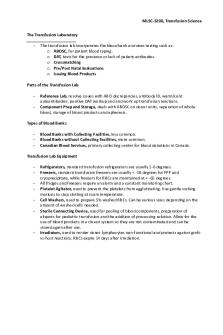K2 - intro to kinesiology PDF

| Title | K2 - intro to kinesiology |
|---|---|
| Course | Intro to Kinesiology |
| Institution | University of Wisconsin-Madison |
| Pages | 3 |
| File Size | 36.2 KB |
| File Type | |
| Total Downloads | 29 |
| Total Views | 146 |
Summary
intro to kinesiology...
Description
angular movement = movement occurs around an axis/pivot joint translatory movement = linear movement all parts of an object move at the same distance in the same direction at the same time Linear movement = EX: all parts of an object/person move at the same distance in the same direction at the same time (Ex: pushing book across the table, person traveling in a car, scapular protraction/retraction) Angular movement = EX: movement that occurs around an axis/pivot joint -depends on amount of force applied and the distance of force from axis of movement (ex: swinging on trapeze, opening a door) dynamic biomechanics = EX: combination of linear and angular movement (ex: running: head/trunk = linear, legs/arms = angular) lever = rigid bar that turns around a fixed axis or a point In the body: ______ represent the bars ______ are the axes ______ contract to apply force bones joints muscles Levers rotate about an axis as a result of... force being applied to cause its movement against a resistance/weight Name the 3 points that determine the type of lever and what motion is best Axis Resistance Force Axis of lever = fulcrum
point of rotation Resistance of lever = weight of a part, body segment or externally applied resistance Force of lever = force/effort that is moving or holding torque = force to rotate an object around an axis, turning force 1st class lever = axis between force and resistance FAR 2nd class lever = resistance between axis and force FRA 3rd class lever = force between axis and resistance AFR 1st class levers produce... -balanced movements when axis is midway between force and resistance (seesaw) -speed and ROM when axis is close to force (triceps in elbow extension) -force motion when axis is close to resistance (crowbar) Example of 1st class lever head balanced on neck in flexing/extending -agonist/antagonist muscles are contracting simultaneously on either side of a joint axis -agonist produces force while antagonist supplies resistance In 1st class lever, force is applied where? where muscle inserts in bone (NOT belly of muscle) 2nd class levers produce force movements, since a large resistance can be moved by a relatively small force Examples of 2nd class levers -wheelbarrow -nutcracker -raising body up on toes
3rd class levers produce speed and ROM movements 3rd class levers require a great deal of force to move even a small resistance Examples of 3rd class lever paddling a boat (resist of water) shoveling biceps brachii in elbow flexion...
Similar Free PDFs

K2 - intro to kinesiology
- 3 Pages

K15 - intro to kinesiology
- 3 Pages

K14 - intro to kinesiology
- 3 Pages

K13 - intro to kinesiology
- 4 Pages

K3 - intro to kinesiology
- 3 Pages

K11 - intro to kinesiology
- 3 Pages

K2-alle Themen
- 18 Pages

Intro to textiles
- 8 Pages

Intro to Med Term
- 41 Pages

Intro to Tinker CAD
- 3 Pages

Intro to Oscilloscopes
- 8 Pages

Intro to Sociology
- 34 Pages

Intro to Transfusion Science
- 3 Pages

Intro to computational physics
- 3 Pages
Popular Institutions
- Tinajero National High School - Annex
- Politeknik Caltex Riau
- Yokohama City University
- SGT University
- University of Al-Qadisiyah
- Divine Word College of Vigan
- Techniek College Rotterdam
- Universidade de Santiago
- Universiti Teknologi MARA Cawangan Johor Kampus Pasir Gudang
- Poltekkes Kemenkes Yogyakarta
- Baguio City National High School
- Colegio san marcos
- preparatoria uno
- Centro de Bachillerato Tecnológico Industrial y de Servicios No. 107
- Dalian Maritime University
- Quang Trung Secondary School
- Colegio Tecnológico en Informática
- Corporación Regional de Educación Superior
- Grupo CEDVA
- Dar Al Uloom University
- Centro de Estudios Preuniversitarios de la Universidad Nacional de Ingeniería
- 上智大学
- Aakash International School, Nuna Majara
- San Felipe Neri Catholic School
- Kang Chiao International School - New Taipei City
- Misamis Occidental National High School
- Institución Educativa Escuela Normal Juan Ladrilleros
- Kolehiyo ng Pantukan
- Batanes State College
- Instituto Continental
- Sekolah Menengah Kejuruan Kesehatan Kaltara (Tarakan)
- Colegio de La Inmaculada Concepcion - Cebu

